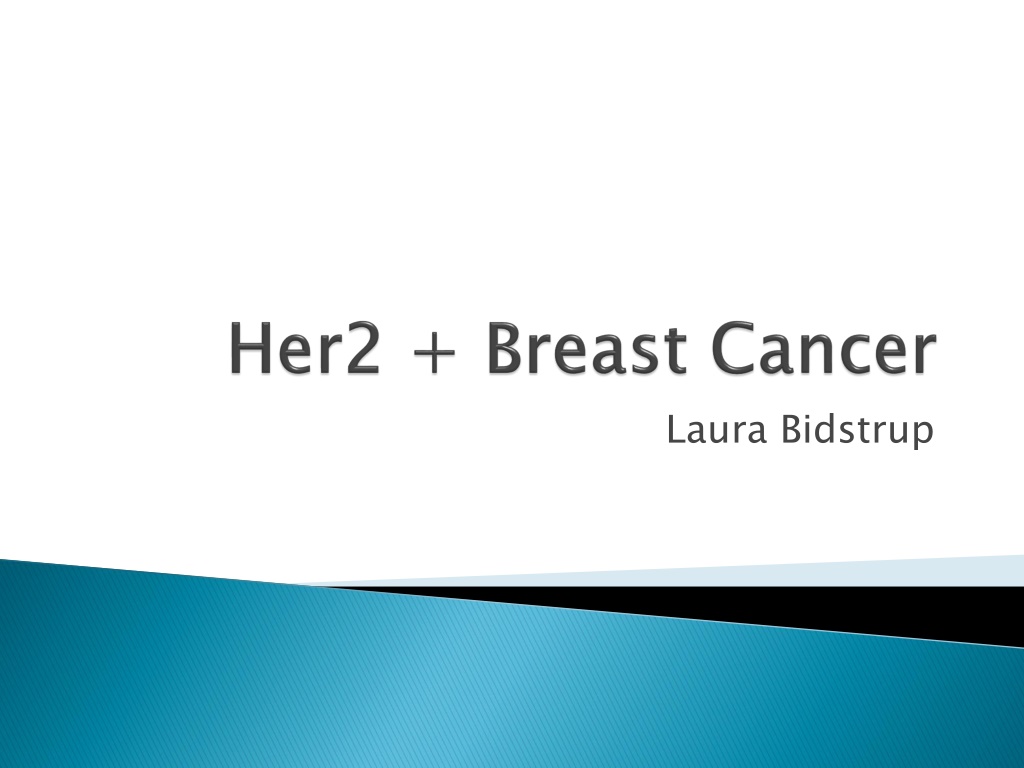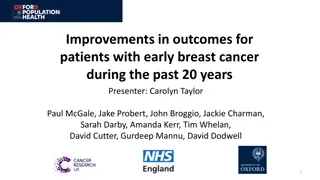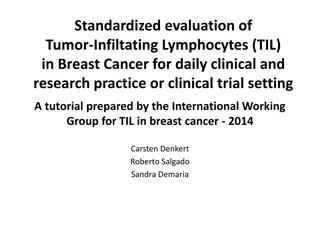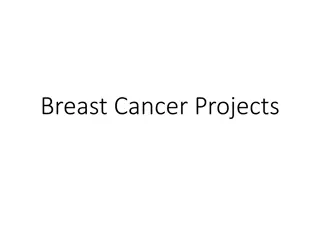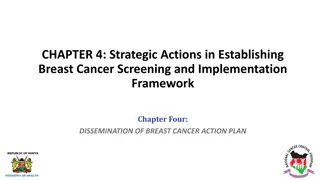Comprehensive Medical History of Mrs. B: Breast Cancer Journey
Mrs. B, a 49-year-old woman, was diagnosed with invasive ductal carcinoma in her left breast in December 2000. She underwent various treatments including surgery, chemotherapy, radiotherapy, and targeted therapies like Herceptin. Despite complications and ongoing pain, she has shown resilience through her cancer journey. Her medical history includes surgeries, medications, family history, and social aspects.
Download Presentation

Please find below an Image/Link to download the presentation.
The content on the website is provided AS IS for your information and personal use only. It may not be sold, licensed, or shared on other websites without obtaining consent from the author. Download presentation by click this link. If you encounter any issues during the download, it is possible that the publisher has removed the file from their server.
E N D
Presentation Transcript
Mrs B is a 49 yo woman who attended for a regular 3 weekly review and Herceptin dose
Dec 2000: present in L) breast for 6/12. Bx- breast ca Jan 2001: Feb 2001: Cyclophosphamide, followed by adjuvant radiotherapy May 2001 Feb 2005: mets Mar 2005: radiotherapy. Monthly Herceptin & Zometa Nov 2006: Jan 2007: Jan 2010: Mar 2010: GIT upset Dec 2000: attended GP regarding lump that had been Jan 2001: Lumpectomy & axillary clearance Feb 2001: Commence 4 cycles Doxorubicin & May 2001- - May 2003: Feb 2005: Nerve pain in R) arm, CT demonstrated 1strib May 2003: Tamoxifen, Zoladex Mar 2005: Commenced 4 cycles Docetaxel, followed by Nov 2006: Herceptin toxicity Jan 2007: Recommenced Herceptin Jan 2010: Inc R) arm nerve sx, MRI shows no change Mar 2010: Admitted for 2/7 due to analgesia-related
Oct 2010: modalities. Radiographic change on MRI; subacute post-ganglionic C8T1/lower trunk brachial plexus region Nov 2010: Mar Jan 2012: hand, retired. Dec 2013 Feb 2014: discontinued Present Oct 2010: Pain sx continuing despite various rx Nov 2010: Radiotherapy Mar July 2011: Jan 2012: Pain controlled, dec fine motor in R) July 2011: Commence 4 cycles abraxane Dec 2013: Tooth infection Feb 2014: Bony spurs/abscess in mouth; Zometa Present: Herceptin 3 weekly, specialist reviews
Attended GP w/ ~6/12 hx of breast lump in L) UO quadrant FNA unsuccessful Core bx: Invasive Ductal Carcinoma BRE grade 3 (poorly differentiated) Nil other symptoms Lumpectomy w/ axillary clearance Uncomplicated procedure Dx: Stage IIa (T2N0M0) invasive ductal carcinoma with surrounding high-grade solid DCIS ER + / PR + / c-erbB-2 (Her2) + Margins clear, 12 benign LN harvested Commenced chemotherapy
Current medications: Femara, coversyl plus, cipramil, prophylactic abx (dental) Phx Bilateral oophorectomy (2005) HTN Depression Menstrual hx normal Was on OCP for many years
FHx Paternal grandmother: sigmoid ca (60) Father: ? Throat ca (71) Nil other relevant family hx Social Mrs B lives with her husband and pets in a Melbourne suburb. She and husband were initially planning to have kids approx at time of initial diagnosis Worked as community health nurse until deteriorating R) hand function prompted retirement in 2010. Now on disability pension. Smoking hx: occasional when young adult Alcohol: average 5 per night Poor diet/exercise
Initial Dx: Invasive Ductal Carcinoma, Stage IIa (T2N0M0) Rx: 4 cycles Doxorubicin & Taxol (paclitaxel) Secondary dx: Invasive Ductal Carcinoma with bony metastases, Stage IV (T2N0M1) Rx: 4 cycles Docetaxel Recurrence: 4 cycles Nab-paclitaxel Additional medications Hydrocortisone Phenergan Aprepitant (CINV) Palonsteron (CINV) NaCl (hydration)
4 cycles Doxorubicin & Taxol Effects: Nil documented information Mrs B reports nil significant issues ~ ?well tolerated
2001-2005 2 years Tamoxifen and monthly Zoladex Nil issues at R/V Regular CT/mammograms clear Ca markers stable 2005: neuropathic R) shoulder & arm pain; metastatic tumour at R) 1strib on imaging
4 cycles Docetaxel plus Herceptin Effects: Well tolerated Nil nausea/vomiting, appetite normal, nil weight loss Some fatigue, ECOG 0-1 Commenced 6 weekly Zometa Bone-protective, for cx from bony mets/Zoladex etc
Echo demonstrated Herceptin toxicity Nov 2006, rx delayed until cleared in 2007 Nil concerns on R/V 2008: Progressing well. On Herceptin, Arimidex (anastrozole), Zometa Mammograms normal, some inc density in L) UIQ stable since 05 2010: Increasing R) arm neuropathic pain Burning/tingling/numbness Gastric upset/weight loss due to analgesia; Naprosyn discontinued, Durogesic increased (later ceased) MRI: rib/T1 body lesion shows nil change Neuropathic sx increase, from shoulder to hand, wasting of palmar muscles, R) hand weakness and decreasing fine motor Attended various specialists including pain clinic; on lyrica, cortisone, panadeine forte, morphine, ?methadone. Stellate ganglion block ineffective, 5/7 ketamine infusion ineffective November: radiographic change, disease progression
4 cycles Abraxane (+ Herceptin) Effects: Some fatigue, decreased motivation ECOG 2 Nil nausea/vomiting, appetite fine, nil weight loss Nil peripheral neuropathy Mild skin peeling L) hand, ?fungal infection Nil other SE April: febrile, brief admission On letrozole
2012: Development of bilateral knee pain and R) elbow pain. Nil evidence metastatic; degen change and ?synovitis/soft tissue injury respectively Increasing loss of fine motor skill in R) hand 2013-14: Tooth infection; attended specialist. Bony spurs in mouth due to Zometa, abscess formation in floor of mouth near exposed bone. 2ndto Bisphos related osteonecrosis of jaw. Otherwise well, continuing on 3 weekly Herceptin.
Incidence: Leading cause of cancer death in women > 65 Invasive breast ca <50yo: 44/100,000 >50yo: 345/100,000 Bimodal incidence: poorly differentiated, high-grade disease usually occur earlier (~50s), whereas hormone-sensitive, slower-growing tumors are later (~70s) Mortality: The 2013 estimates are 39,920 expected breast cancer deaths (39,510 women, 410 men) Aetiology: Multifactorial; sporadic vs genetic predisposition
Phx of breast ca (esp invasive): 3-4x risk of a second primary cancer in the contralateral breast Family hx >2 relatives with breast/ovarian cancer Breast cancer in relative <50 yo Relatives with both breast cancer and ovarian cancer One or more relatives with 2 cancers (breast and ovarian cancer or 2 independent breast cancers) Male relatives with breast cancer BRCA1 and BRCA2 mutations Ataxia telangiectasia heterozygotes (4x risk) Ashkenazi Jewish descent (2x risk) High SES Advanced age Caucasian Late age at first pregnancy/nulliparity Early onset of menses/late age of menopause/HRT Long term OCP use Western diet Obesity/sedentary lifestyle Smoking/alcohol/carcinogens
Pathophys: Dependent on cell morphology Ductal vs Lobular Invasive vs noninvasive Markers (ER/PR/HER2) present/absent Spread: Lymphatic Vascular invasion Local invasion Sites Regional LN, skin, bone, liver, lung, brain
Sx Primary: Asymptomatic, painless mass, breast pain (rare) Mets: Dyspnoea Bone pain Symptoms of hypercalcemia Abdominal distension Jaundice Localizing neurologic signs Altered cognitive function Headache Clinical signs Change in breast size or shape/contour Skin dimpling or skin changes (eg, thickening, swelling, tethering, Pagets, redness, ulceration, dilated veins, oedema) Recent nipple abnormalities (eg, ulceration, retraction, or spontaneous bloody discharge) Lump (Hard/irreg/nodular/asymmetry/fixation)
Ix Clinical exam US Mammography Bx (FN, core, excisional etc) XR/CT/MRI/PET Ddx Fibroadenoma Cysts Breast lymphoma Metastasis to the breast Mastitis Traumatic fat necrosis Duct ectasia
Primary tumour (T) Tx: Primary tumor cannot be assessed T0: No evidence of primary tumor Tis: DCIS/LCIS/Paget disease of the nipple with no tumor T1: Tumor 2 cm in greatest diameter T1mic: Microinvasion 0.1 cm (in greatest diameter) T1a: Tumor >0.1 but not >0.5 cm T1b: Tumor >0.5 but not >1 cm T1c: Tumor >1 cm but not >2 cm T2: Tumor >2 cm but not >5 cm T3: Tumor >5 cm T4:Tumor of any size, with direct extension to (a) the chest wall or (b) skin only T4a: Extension to the chest wall, not including the pectoralis T4b: Oedema (eg peau d orange) or ulceration of the skin of the breast or satellite skin nodules confined to the same breast T4c: Both T4a and T4b T4d: Inflammatory disease
Regional lymph nodes (N) Nx: Regional lymph nodes cannot be assessed N0: No regional lymph node metastasis N1: Metastasis in movable ipsilateral axillary lymph node(s) N2: Metastasis in ipsilateral axillary lymph node(s) fixed or matted, or in clinically apparent ipsilateral internal mammary nodes in the absence of clinically evident axillary lymph node metastasis N2a: Metastasis in ipsilateral axillary lymph nodes fixed to one another or to other structures N2b: Metastasis only in clinically apparent ipsilateral internal mammary nodes and in the absence of clinically evident axillary lymph nodes N3: Metastasis in ipsilateral infraclavicular or supraclavicular lymph node(s) with or without axillary lymph node involvement, or clinically apparent ipsilateral internal mammary lymph node(s) and in the presence of axillary lymph node N3a: Metastasis in ipsilateral infraclavicular lymph node(s) N3b: Metastasis in ipsilateral internal mammary lymph node(s) and axillary lymph node(s) N3c: Metastasis in ipsilateral supraclavicular lymph node(s)
Distant metastasis (M) Mx: distant metastasis cannot be assessed M0: no distant metastasis M1: distant metastasis present Stage grouping Stage 0: Tis, N0, M0 Stage I: T1, N0, M0 Stage IIA: T(0-2), N(0-1), M0 Stage IIB: T(2-3), N(0-1), M0 Stage IIIA: T(0-3), N2, M0 Stage IIIB: T4, N(0-2), M0 Stage IIIC: T4, N3; M0 Stage IV: any T, any N, M1
Nottingham grading system: Criteria Tubule formation (?normal duct structure retained) Nuclear grade Mitotic rate Scoring: 1-3 (most-least normal) per criteria Total score: 3 5: G1 (Low grade; well differentiated) 6 7: G2 (Intermediate grade; moderately differentiated) 8 9: G3 (High grade; poorly differentiated)
Prognosis: 5-year survival rates by tumour stage: Stage 0, 99-100% Stage I, 95-100% Stage II, 86% Stage III, 57% Stage IV, 20% Factors Axillary lymph node status Lymphatic/vascular invasion Lymph node positive recurrence rates at 5yr: 1-3 positive nodes 30-40% 4-9 positive nodes 44-70% >10 positive nodes 72-82% Tumor size Patient age Histologic grade Tumour subtypes (IDC, LCIS, etc) Response to neoadjuvant therapy ER/PR status HER2 gene amplification or overexpression
Surgery Lumpectomy Mastectomy +Axillary clearance Chemotherapy Other Radiotherapy; especially in cases of breast-conserving surgery Dec local recurrence risk by 70% Whole breast/partial breast/nodal irradiation Can also be done post-mastectomy SERMs (Tamoxifen, raloxifine)- can delay ER pos tumours ~10yr Aromatase inhibitors (Arimidex, Femara)- postmenopausal women (perpheral block only) Herceptin Bisphosphenates
Background HER2: transmembrane tyrosine kinase receptor (ErbB protein family/epidermal growth factor receptor family) Activation increased activity of molecular pathways assoc with tumor proliferation, deregulation Incidence: HER2 is overexpressed in 18-20% of invasive breast cancers Testing: Immunohistochemistry assay 3+: Positive HER2 expression - Uniform intense membrane staining of more than 30% of invasive tumor cells 2+: Equivocal for HER2 protein expression - Complete membrane staining that is either nonuniform or weak in intensity but has circumferential distribution in at least 10% of cells 0 or 1+: Negative for HER2 protein expression Equivocal additional testing with FISH ( fluorescence in situ hybridization) Positive HER2 amplification: FISH ratio is greater than 2.2 or HER2 gene copy is greater than 6.0 Equivocal HER2 amplification: FISH ratio of 1.8-2.2 or HER2 gene copy of 4.0-6.0 Negative HER2 amplification: FISH ratio is less than 1.8 or HER2 gene copy of less than 4.0 Prognosis: Prior to Herceptin, HER2 overexpression was associated with a more aggressive tumor phenotype and worse prognosis Brain mets now more commonly seen as Herceptin cannot cross BBB Treatment HER2-positive patients benefit from anthracycline-based regimens (eg doxorubicin)
Metastatic breast cancer: Nab-paclitaxel Dose 3 weekly, to be continued until disease progression or unacceptable toxicity SE: Caution: neutropaenic sepsis (admit) Immediate (onset hours to days) Nausea and vomiting Taste and smell alteration Early (onset days to weeks) Anaemia/neutropenia/thro mbocytopenia (delay) Oral mucositis Skin rash maculopapular Fatigue Diarrhoea Hyperlacrimation Arthralgia/myalgia Peripheral neuropathy (dose reduce/delay if >grade 2) Late (onset weeks to months) Alopecia Nail changes Delayed (months to years) Menopausal sx
HERCEPTIN HERCEPTIN Progression free survival trastuzumab produces roughly a 50% improvement in disease-free survival and 33% improvement in overall survival, regardless of the chemotherapy regimen or sequence of trastuzumab delivery Trastuzumab plus chemotherapy was associated with a significant improvement in time to disease progression (7.4 mo vs 4.6 mo), objective response rate (50% vs 32%), and 1-year survival (25.1 mo vs 20.3 mo) compared with chemotherapy alone
Overall survival adjuvant trastuzumab for 1 year improved disease- free and overall survival among women with early- stage HER2-positive breast cancer at 5 years, and found that a nonanthracycline regimen plus trastuzumab had a more favorable risk-benefit ratio than anthracycline- based regimens due to similar efficacy, fewer acute toxic effects, and lower risks of cardiotoxicity and leukemia
Alternatives Ado single agent for treatment of HER2-positive, metastatic breast cancer in patients who have already undergone unsuccessful treatment with trastuzumab and a taxane, either separately or in combination. Pertuzumab elicits action at a different ligand binding site from trastuzumab to prevent HER2 dimerization. The combination of both HER2 receptor antibodies (pertuzumab plus trastuzumab) is superior to either agent alone. Average increase in progression-free survival of 6.1 months in patients receiving pertuzumab in addition to trastuzumab and docetaxel with minimal to no increase in cardiac toxic effects Lapatinib Orally bioavailable TK inhib. SE: rash/diarrhoea. Synergystic w/ trastuzumab. Improves survival Ado- -trastuzumab trastuzumab (Kadcyla): Pertuzumab: : Lapatinib: :
EviQ Best Practice Medscape Manual of Clinical Oncology, seventh ed. Slamon D, Eiermann W, Robert N, Pienkowski T, Martin M, Press M, et al. Adjuvant trastuzumab in HER2-positive breast cancer. N Engl J Med. Oct 6 2011;365(14):1273-83. Baselga J, Cort s J, Kim SB, Im SA, Hegg R, Im YH, et al. Pertuzumab plus trastuzumab plus docetaxel for metastatic breast cancer. N Engl J Med. Jan 12 2012;366(2):109-19. Slamon DJ, Leyland-Jones B, Shak S, Fuchs H, Paton V, Bajamonde A, et al. Use of chemotherapy plus a monoclonal antibody against HER2 for metastatic breast cancer that overexpresses HER2. N Engl J Med. Mar 15 2001;344(11):783-92. Welslau M. Dieras V. Sohn JH. Hurvitz SA. Lalla D. Fang L. Althaus B. Guardino E. Miles D. Patient-reported outcomes from EMILIA, a randomized phase 3 study of trastuzumab emtansine (T-DM1) versus capecitabine and lapatinib in human epidermal growth factor receptor 2-positive locally advanced or metastatic breast cancer.Clinical Trial, Phase III. Journal Article. 120(5):642-51, 2014 Mar 1.
